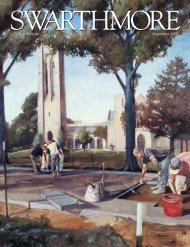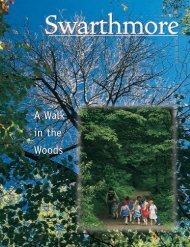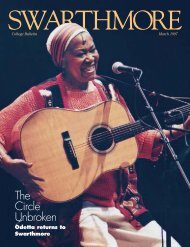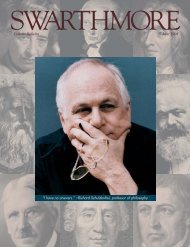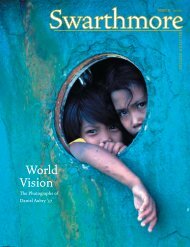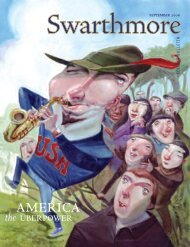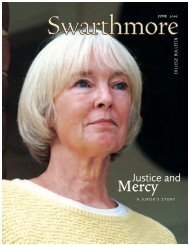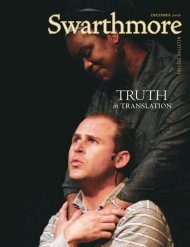Vietnam
Swarthmore College Bulletin (June 2006) - ITS
Swarthmore College Bulletin (June 2006) - ITS
- No tags were found...
Create successful ePaper yourself
Turn your PDF publications into a flip-book with our unique Google optimized e-Paper software.
may now choose what level courseshould be designated as a W. In physics,for instance, Associate Professor CarlGrossman says the advanced laboratorycourse, taken by upperclassmen, servesas the department’s lone W offering.Students write four 10-page laboratoryreports in components, incorporatingthorough revisions throughout theprocess. In contrast, the introductoryPhysics 006 course, which, as a PDC,required students to write humanitiesstylepapers, has morphed into a moremathematically oriented class, Grossmansays.The flexibility of the Ws also haspotential pitfalls. There are some concernsthat not enough W courses areavailable, particularly in departmentsthat face enrollment pressures, such as economicsand political science, and at theintroductory level for the natural sciences,says Peter Schmidt, professor of English literatureand department chair. Schmidtserved as chair of the Writing ProgramReview Committee, which met throughoutthe year to evaluate the Writing AssociatesProgram, the College’s peer feedback initiative.The committee finished its work thisspring.Although the committee didn’t formallyevaluate the relatively new Ws, Schmidt saysthat student feedback indicates some frustrationregarding the shortage in W courses,the variation in what counts as a W acrossthe disciplines, and the fact that somewriting-intensive courses aren’t designatedas Ws.“There’s lots of good will toward improvinghow well we teach writing, but we don’tyet know what the best formats for doingthis will be,” Schmidt says.A fundamental point to understand aboutSwarthmore’s writing program is that it’snot easily defined. The authority for curricularofferings rests with the faculty andadministration, but much of the day-to-daywork falls to the Writing Associates (WA)If writing allowsstudents tomore deeply engagein intellectualdiscourse, how can acollege best ensurethat studentsmaster its practice?Program, a group of about 70 peer reviewerswhose role at Swarthmore is comfortablyinstitutionalized. Most WAs are assigned tospecific courses, but the program also offersdrop-in help at the Writing Center and, onspecial request, writing associate mentors(WAMs) who enter into semester-long partnershipswith individual students.The WA program was started in the1980s under the guidance of Thomas Blackburn,Centennial Professor Emeritus ofEnglish Literature. Until then, he says, theCollege hadn’t done much in the way ofovert writing instruction beyond offeringEnglish 1A, a composition class formedin the 1960s as part of an effort to providewriting support to a student body witha more diverse range of preparation forcollege.There had also been an advanced courseon exposition at one time, Blackburn says,plus a 1960s-era requirement that civil andmechanical engineering students take aclass on speaking and writing, “with theprejudicial assumption that engineers aren’tgood at that,” Blackburn says. Electricalengineers were exempt, “Again, on the prejudicialassumption they were smarter thanthe others.”In contrast, the Writing Associates Program,developed to support the newPDCs, immediately targeted a widecross-section of the student body. WAswere paired with courses and asked toreview the work of every student in theclass. Syllabi would include two separatedue dates for a paper: one for the “WAcopy” and the other for the final draft tothe professor. The unique structure ofthe program, which today serves about20 to 25 courses per semester, may beone reason why Swarthmore’s WritingAssociates Program has largely avoided aremedial stigma among students. Itwould be difficult to get throughSwarthmore without having to handover a WA copy—no matter how strongor weak a student’s skills.“For the size of Swarthmore, the WAProgram is quite large and really intertwinedin the culture of the school,” says Jill Gladstein,assistant professor of English literatureand director of the program since 2001.Students clamor for the paid WA positions,and—keeping up the program’s tradition ofinstitutionalized acronyms—spend a semestertraining as “WAITs” (WAs in training)before they drop their “IT.” PotentialWAs must be nominated, make it throughan increasingly selective application process(the number of applicants is the highest ithas been in 5 years), and take a trainingcourse for credit.Students turn to WAs for last-minutehelp and long-term partnerships. Nearly450 students sought advice at the WritingCenter in 2004–2005, according to WA statistics,and 1,273 total papers were “WAed”at the center (English, political science, andeconomics papers were among the mostcommonly reviewed). Although most studentswho use the center are freshmen andsophomores, the numbers don’t drop dramaticallyfor upperclassmen: in 2004, 33percent of users were freshmen, 29 percentsophomores, 18 percent juniors, and 19 percentseniors. In addition, some alumni sentgraduate school applications or other materialsto be reviewed.june 2006 : 27



